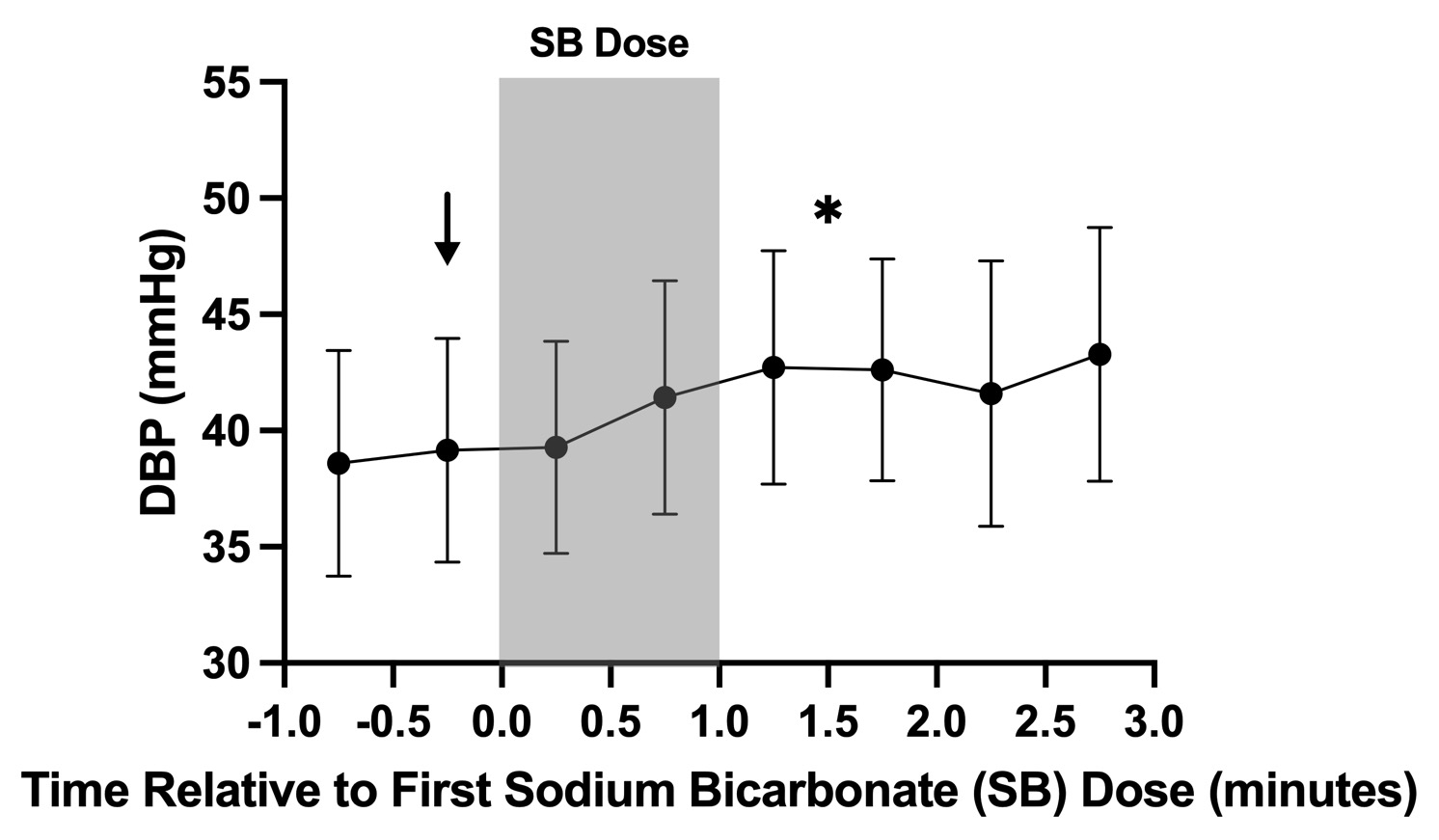Final ID: Sa805
Diastolic Blood Pressure Response to Sodium Bicarbonate Administration in Pediatric In-Hospital Cardiac Arrest
Abstract Body: Background: Despite national guidelines recommending against its routine use, sodium bicarbonate (SB) is administered in approximately 50% of pediatric in-hospital cardiac arrests (p-IHCA). This may partially be explained by the commonly held belief that SB administration increases extracellular pH and mitigates myocardial depression associated with intra-arrest acidosis. However, physiologic response to SB during p-IHCA has not been previously described and may provide insight for its use during cardiopulmonary resuscitation (CPR).
Aim: To explore diastolic blood pressure (DBP) response to SB administration during p-IHCA.
Hypothesis: We hypothesized that SB administration would be associated with increased DBP.
Methods: Retrospective single center study of patients ≤ 18 years old who experienced pulseless IHCA and received intra-arrest SB with an arterial line present from 2013 to 2023. Events in which epinephrine was given in the same minute as the first dose of SB were excluded. Events were divided into 30-second epochs for which the average DBP was calculated using stored monitor data. The 30-second epoch prior to the minute of SB administration was used as the baseline. The primary outcome was the change in DBP one minute post-SB administration, defined as the average of the 2 epochs after the full minute of SB administration. We also performed a sensitivity analysis, expanding the post-SB period as the 4 epochs (2 minutes) after SB administration for patients with ongoing CPR and without epinephrine administration in the interim period. Change in DBP was compared using a paired t-test.
Results: In the 32 events included, the mean DBP 1minute post-SB administration significantly increased from 39.2 mmHg to 42.7 mmHg (mean difference 3.5, 95% CI: 0.4, 6.6, p = 0.03). Sensitivity analysis (n=24) at 2 minutes post-SB administration showed a change in mean DBP from 41.2 mmHg to 43.5 mmHg (mean difference 2.3 mmHg, 95% CI: -0.8, 5.05 p = 0.13).
Conclusions: SB administration during p-IHCA was associated with a significant increase in DBP 1 minute post-SB, but the increase in DBP did not reach statistical significance when averaged over 2 minutes post-SB. Given known associations between DBP and outcomes in p-IHCA, these results support the need for further investigation of physiologic response and clinical outcomes associated with intra-arrest SB administration.
Aim: To explore diastolic blood pressure (DBP) response to SB administration during p-IHCA.
Hypothesis: We hypothesized that SB administration would be associated with increased DBP.
Methods: Retrospective single center study of patients ≤ 18 years old who experienced pulseless IHCA and received intra-arrest SB with an arterial line present from 2013 to 2023. Events in which epinephrine was given in the same minute as the first dose of SB were excluded. Events were divided into 30-second epochs for which the average DBP was calculated using stored monitor data. The 30-second epoch prior to the minute of SB administration was used as the baseline. The primary outcome was the change in DBP one minute post-SB administration, defined as the average of the 2 epochs after the full minute of SB administration. We also performed a sensitivity analysis, expanding the post-SB period as the 4 epochs (2 minutes) after SB administration for patients with ongoing CPR and without epinephrine administration in the interim period. Change in DBP was compared using a paired t-test.
Results: In the 32 events included, the mean DBP 1minute post-SB administration significantly increased from 39.2 mmHg to 42.7 mmHg (mean difference 3.5, 95% CI: 0.4, 6.6, p = 0.03). Sensitivity analysis (n=24) at 2 minutes post-SB administration showed a change in mean DBP from 41.2 mmHg to 43.5 mmHg (mean difference 2.3 mmHg, 95% CI: -0.8, 5.05 p = 0.13).
Conclusions: SB administration during p-IHCA was associated with a significant increase in DBP 1 minute post-SB, but the increase in DBP did not reach statistical significance when averaged over 2 minutes post-SB. Given known associations between DBP and outcomes in p-IHCA, these results support the need for further investigation of physiologic response and clinical outcomes associated with intra-arrest SB administration.
More abstracts on this topic:
A Case of Successful Resuscitation After Out-of-hospital Cardiac Arrest Caused by Undiagnosed Pheochromocytoma-induced Cardiomyopathy
Hatakeyama Toshihiro, Suetsugu Yusuke, Watanabe Kaoru, Matsushima Hisao
A Community Outreach Program Focused on Hypertension Awareness Reaches 600+ People in Rural Georgia and Works to Build the Next Generation of Biomedical ScientistsDent Elena, Ilatovskaya Daria, Pinkerton Brittany, Crider Emily, Ryan Michael, Sullivan Jennifer

